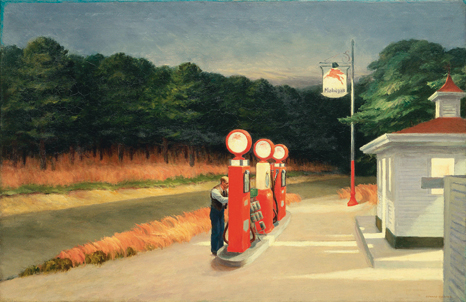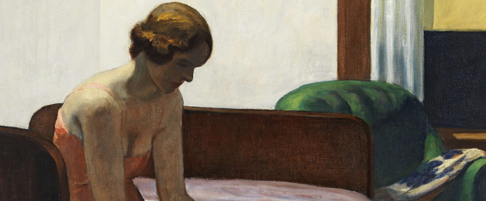Hopper

The American Landscape

Landscape had been the most important genre within 19th-century American
painting. While Hopper also produced other types of paintings, the
rapid rise of his reputation in the 1920s was largely due to his works of
this type. Nonetheless, his approach marked a radical break from the 19thcentury
tradition as it focused on urban views of Manhattan and the residential
areas of the suburbs. Hopper made no concessions to his subjects,
emphasising the vulgar, inhospitable nature of these places. A characteristic
example is his depiction of the suspension bridges that join Manhattan
and Brooklyn, great works of engineering that appealed to the
popular imagination but which the artist presented as harsh, desolate
areas in which the only element that seems to interest him is the bridges’
visual complexity.
While Hopper also painted open landscapes, often located on the outskirts
of Cape Cod where he had built a studio-house for his summer holidays,
his favourite themes continued to be manmade constructions. Over
the years he devoted increasing attention to isolated houses, frequently
presenting them as signs or manifestations of a particular lifestyle and
attitude. Two Puritans offers a good example of this transformation of
the architectural into the psychological.

Edward Hopper (Nyack, 1882 - New York, 1967). Gas.
- Año
- 1940.
- Técnica
- Oil on canvas. 66.7 x 102.2 cm.
- Propiedad
- The Museum of Modern Art, New York,
Mrs Simon Guggenheim Fund; inv. no. 577.1943
In addition to the houses in his paintings, Hopper also depicted
roads, gas stations and railway lines and stations, all constructions associated
with geographical mobility and rootlessness, social traits that
were increasingly evident with the economic depression of the 1930s
and which became profoundly inscribed in the collective American
imagination.
During the last fifteen years of his life the artist worked even more
slowly while his compositions became increasingly simple, his application
of the paint dryer and lighter and his scenes more expressive, in
some cases to the point of evoking the work of the Early Italian Primitives
such as Giotto. A good example of all these characteristics is South
Carolina Morning.




